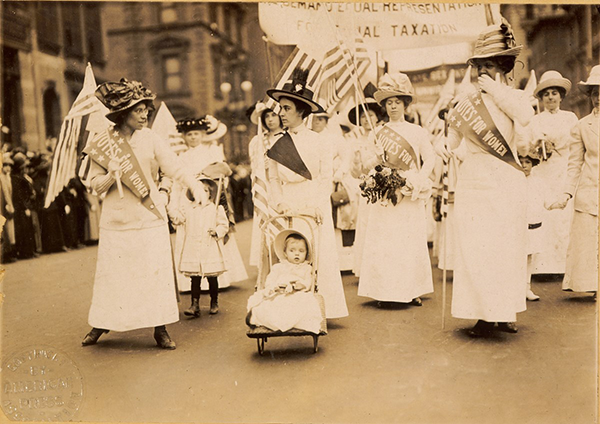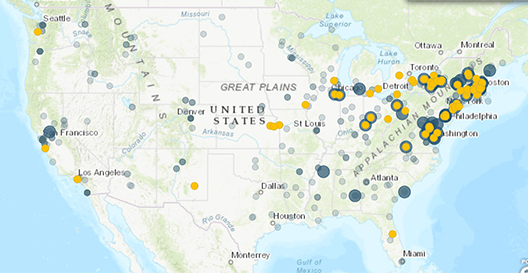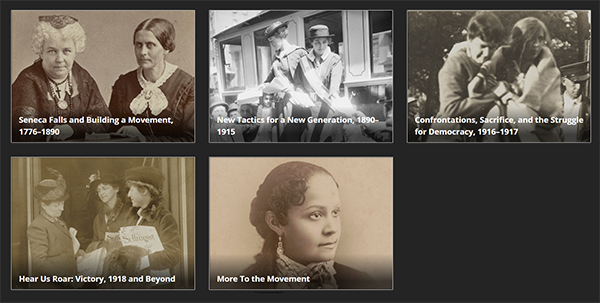National Women's Equality Day - August 26
Missouri became the 11th state to ratify the 19th Amendment with the signature of Governor Frederick Gardner on July 10, 1919.
Pictured here, he is surrounded by Suffragists who worked tirelessly from the grassroots up to accomplish their mission.
Read more from the Missouri Almanac - Fighting for the Franchise: the 19th Amendment in Missouri.
In 1971, the U.S. Congress designated August 26 as National Women's Equality Day as it was the day of adoption of the Nineteenth Amendment (Amendment XIX) to the United States Constitution in 1920. The Nineteenth Amendment prohibits the states and the federal government from denying the right to vote to citizens of the United States on the basis of sex. The lead-up to this day involved many decades of hard work, organizing and perseverance to create the opportunity for women to have the right to vote. The amendment was first introduced in 1878.
 The rich history of women's suffrage is a landscape of women - and men - fighting for voting equality, and their countless stories of inspiration, heartbreak, victory, tragedy, agreement, disagreement and organizing. Amazing to think that it all happened without the internet!
The rich history of women's suffrage is a landscape of women - and men - fighting for voting equality, and their countless stories of inspiration, heartbreak, victory, tragedy, agreement, disagreement and organizing. Amazing to think that it all happened without the internet!
To honor and celebrate National Women's Equality Day, we offer some resources to learn more. We would like to give special recognition to the amazing interactive historical archive and educational information produced in 2020 by the National Park Service.
Did you know that, while many women were able to head to the polls after the 19th Amendment passed, the amendment did not give voting rights to all women?
Learn more at A Crash Course on the 19th Amendment, and read about African American Women and the Nineteenth Amendment. Follow up as you can with one-minute episodes from the video series entitled Suffrage in Sixty Seconds.
Suffrage Stories and Resources from the National Park Service
The passage of the 19th Amendment celebrated a centennial last year, and the U.S. National Park Service (NPS) compiled a fantastic collection of suffrage information. The NPS 19th Amendment website is an interactive and engaging collection of ways to learn about the history of the 19th Amendment and its significance.
Maps and Suffrage Connections
A collection of maps and historical sites produced by Towson University in Maryland, Explore Suffragist Stories and Connections is a can't-miss map-based learning tool. Plan a road trip to visit some of the suffrage sites near you that shaped our country.
Women and Social Movements in the United States, 1600-2000
Women and Social Movements in the United States, 1600-2000 is a resource for students and scholars of U.S. history and U.S. women's history provided by Alexander Street. Browse the Online Biographical Dictionary of the Woman Suffrage Movement in the United States that hosts the crowd-sourced biographies of thousands of women involved in the suffrage movement.
Library of Congress Suffrage Exhibition
 We hold these truths to be self-evident: that all men and women are created equal. . . . In entering upon the great work before us, we anticipate no small amount of misconception, misrepresentation, and ridicule; but we shall use every instrumentality within our power to effect our object.
We hold these truths to be self-evident: that all men and women are created equal. . . . In entering upon the great work before us, we anticipate no small amount of misconception, misrepresentation, and ridicule; but we shall use every instrumentality within our power to effect our object.
—Elizabeth Cady Stanton, Declaration of Sentiments, 1848
